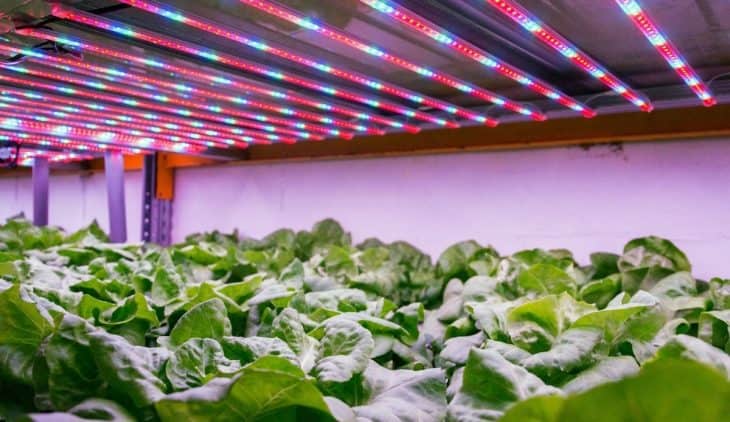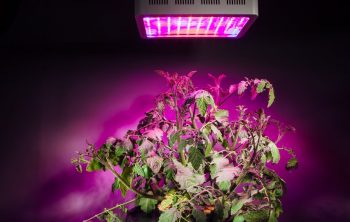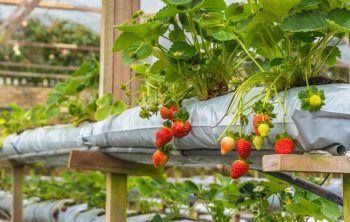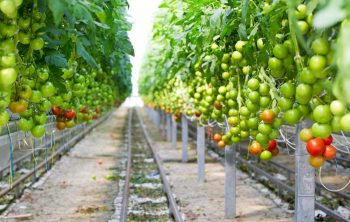You might be interested in growing lettuce hydroponically and wondering what the light requirements are. This is why we have put together information on hydroponic lettuce light requirements for you.
One simple vegetable to grow with hydroponics is lettuce and it’s a perfect vegetable to start with especially for beginners. Lettuce plants grown in hydroponics are fast and easy to maintain. They can be grown all year round in a controlled environment. They don’t take much space and their growing requirements are very easy to meet.
Hydroponic Lettuce Growing Light Requirements
Lettuce is a minimally demanding plant when grown hydroponically. Even at that, certain care is still needed for their growing requirements and light is one of these requirements. So let’s look at some of the hydroponic lettuce light requirements.
Light Duration Requirement
The adequate light duration for lettuce is about 10 to 12 hours. Lettuce is a low-light plant and it won’t do well in full sun. Full light from the sun can cause lettuce to go into the flowering phase (bolt) and turn bitter.

Temperature
Lettuce does well in cooler temperatures. The high temperature will cause your lettuce plant to bolt or go into the flowering phase. When this happens, your lettuce plant will taste annoyingly bad. The appropriate temperature during the day should be from 65 to 70 degrees Fahrenheit. When the temperature surpasses 75 degrees Fahrenheit, your lettuce plant will start to flower or bolt. Moderately low temperatures at night of around 60 to 65 degrees Fahrenheit are great for lettuce. During summer, lettuce does not grow that fast, but it does grow.
Grow light
Lettuce does not require much light. So for this reason, most growers go for fluorescent lighting. Fluorescent lighting does not cost much, power consumption is low, and heat production is minimal. It is just the right grow light match for your lettuce plant.
Other Growing Requirements For Lettuce
Let’s take a look at some other growing requirements:
- Growing Media: you can make use of Rockwool cubes as your starters for your hydroponic systems. Rockwool has a naturally high pH. So if you are opting for Rockwool, make sure you balance your pH before you proceed to plant. Other options for growing media are coconut coir and peat moss.
- pH Range: the appropriate adjusting pH range for lettuce is 5.5 to 6.0.
- Nutrient Solutions: The nutrient solution for lettuce is very essential. This is because it majorly serves as the growing medium for your lettuce plant to grow. Lettuce does not demand too many nutrients, but its nitrogen demand is pretty high. The nutrient solution with an N-P-K ratio should be high in nitrogen, have a little phosphorous, and not so much potassium. The nutrient solution should be able to yield great production as well as prevent it from entering the flowering phase (i.e. bolting). Calcium is also an essential nutrient for lettuce varieties that are prone to tip burning. Thus, ensure you feed the nutrient solution with a good portion of calcium.
Types Of Low Light Lettuce Grown In Hydroponic
Below are the commonly grown types of hydroponic lettuces:
- Butterhead Lettuce: butterhead lettuce is one popularly grown hydroponics lettuce that is a low light plant requirement. It consists of two types: Boston lettuce and Bibb lettuce.
- Loose-leaf Lettuce: Loose-leaf lettuce is also minimal light lettuce. This type of lettuce does not usually form heads.
- Romaine Lettuce: romaine lettuce is also a commonly grown lettuce. It is the major recipe for Caesar salad and its taste is a string and the texture is crispy. It is also a low-light plant. Romaine lettuce has various varieties such as open heads and tighter heads.
Lettuce Growing Period
Lettuce grows short-term and fast. The duration in which the head of your lettuce plant ripens will depend on the variety. Usually, it takes about 3 weeks for the first edible leaf to emerge and about 45 to 85 days to get the full head harvest.
How to Build a Hydroponic System For Lettuce?
Building a hydroponic system for lettuce is a fun and rewarding project. It allows you to produce lettuce year-round, indoors or out. Here are the steps you can follow to build your hydroponic system:
- Choose A Location: Where you build your hydroponic system is essential. You need to ensure it has access to enough direct sunlight and an electrical outlet if you are not using solar panels.
- Gather Your Materials: You will need a large container like a tub or barrel for the nutrient solution. Another tray or container should hold your lettuce and water. You’ll also need a water pump, tubing, and timer.
- Set Up The Nutrient Solution: Fill the container with water and add a nutrient solution according to the package instructions. The nutrient solution provides the plants with all the necessary nutrients to grow.
- Add The Lettuce Plants: Plant lettuce seeds or seedlings in small pots or plugs filled with a soilless growing medium, like coconut coir or peat moss. Place the pots or plugs in the container.
- Connect The Water Pump and Tubing: Use the tubing to connect the water pump to the container of nutrient solution. Set the timer to control the frequency and duration of the water pump.
- Monitor and Maintain The System: Check the nutrient solution regularly and add more as needed. Monitor the pH and temperature of the solution and adjust as needed. Harvest your lettuce when it is ready to eat.
What’s The Best Grow Light?
Several parts determine the efficiency of a grow light. The type best for your setup will depend on your specific needs. You can keep these light features in mind when choosing a grow light:
Spectrum
All plants have different light spectrum requirements. Lettuce, for example, prefers a range high in blue light. Fruiting plants like tomatoes and peppers like a spectrum high in red light. You should choose one that’s most suited for your plants.
Intensity
The intensity of the grow light is important for ensuring that the plants receive enough light to grow properly. You can determine the power of light using a PAR meter or the manufacturer’s recommendations.
Coverage Area
Consider the size of the area you want to cover with the grow light and choose a light that can do this.
Energy Efficiency
Grow lights can be energy-intensive. It is essential to choose an energy-efficient light to save on electricity costs.
Standard grow lights include fluorescent, LED and HID lamps. Each type has its benefits and drawbacks, so it is important to do your research and choose the one best suited for your needs.
What Size Grow Light Do I Need For Two Plants?
The size of the grow light you need for two plants will depend on the plant’s specific needs. These include their light spectrum and light intensity requirements. The size of the plants also impacts this.
Generally, you need at least 30 watts of light per square foot of growing space. Two plants need at least 60 watts. You should consider the coverage area and spectrum needs of your plants when choosing a light.
It is also important to monitor the plants as they grow. You might have to adjust the size of your grow light. If the plants are not receiving enough light, they may become spindly or fail to thrive. On the other hand, they may become stressed or burnt if they receive too much light.
How Long Does it Take to Grow Lettuce in a Hydroponic System?
Lettuce takes about 4 to 6 weeks to grow. Some varieties can take longer to mature. You should maintain your hydroponic system to ensure your lettuce grows as quickly as possible. This includes keeping the nutrient
Final Note
Growing lettuce hydroponically is of great benefits and you can grow any variety of lettuce in your hydroponics system. Lettuce has low light requirements and they are fast-growing. So be assured of ready available nutritious leafy green at your disposal.
Lettuce will take about 21 days to grow its edible leaves and 45 to 85 days for its full head to be ready for harvest. Its requirements are not too hard and it is one of the easiest plants to grow hydroponically.

Eunice is an enthusiastic gardener with a passion for growing beautiful flowers. She loves nothing more than spending time in her garden, tending to her plants and enjoying the outdoors. Eunice has been gardening for over 15 years and has developed a unique style of landscaping that is both practical and aesthetically pleasing. She is especially fond of growing roses and enjoys experimenting with different varieties and colors. Eunice takes great pride in her garden and often shares the fruits of her labor with friends and family. In her spare time, she enjoys reading gardening magazines and attending local horticulture events. Eunice is passionate about her hobby and is always eager to share her knowledge and experience with others.





